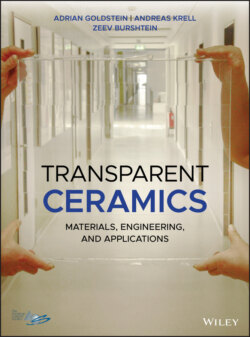Читать книгу Transparent Ceramics - Adrian Goldstein - Страница 22
1.5 Evolution of Transmissive Ability Along the Ceramics Development History
ОглавлениеThere are three varieties of transmissive polycrystalline ceramics, which differ markedly as to the mechanism conferring them that optical property. The first family (dominant phases are crystalline), representatives of which were already fabricated more than 1000 years ago (porcelains as an example), owe their transparency, low or moderate, to a certain content of glassy phase(s). The second family contains materials that include glassy and crystalline phases, which are both transmissive; most of glass-ceramics belong to this family. The third family, of all-crystalline materials, owe its transparency to the fact that the specific crystalline phases are transparent. Members of this family usually contain less than 1% of non-crystalline residues (see Section 1.3.1; paragraph preceding Figure 1.2).
This book's major topic is the realm of all-crystalline ceramics. Glass-ceramics are also considered, but not discussed in detail. In our view, their phase assemblage makes them a topic that deserves an independent comprehensive treatment; their discussion is mandatory for both books concerned with glass and with ceramics.
